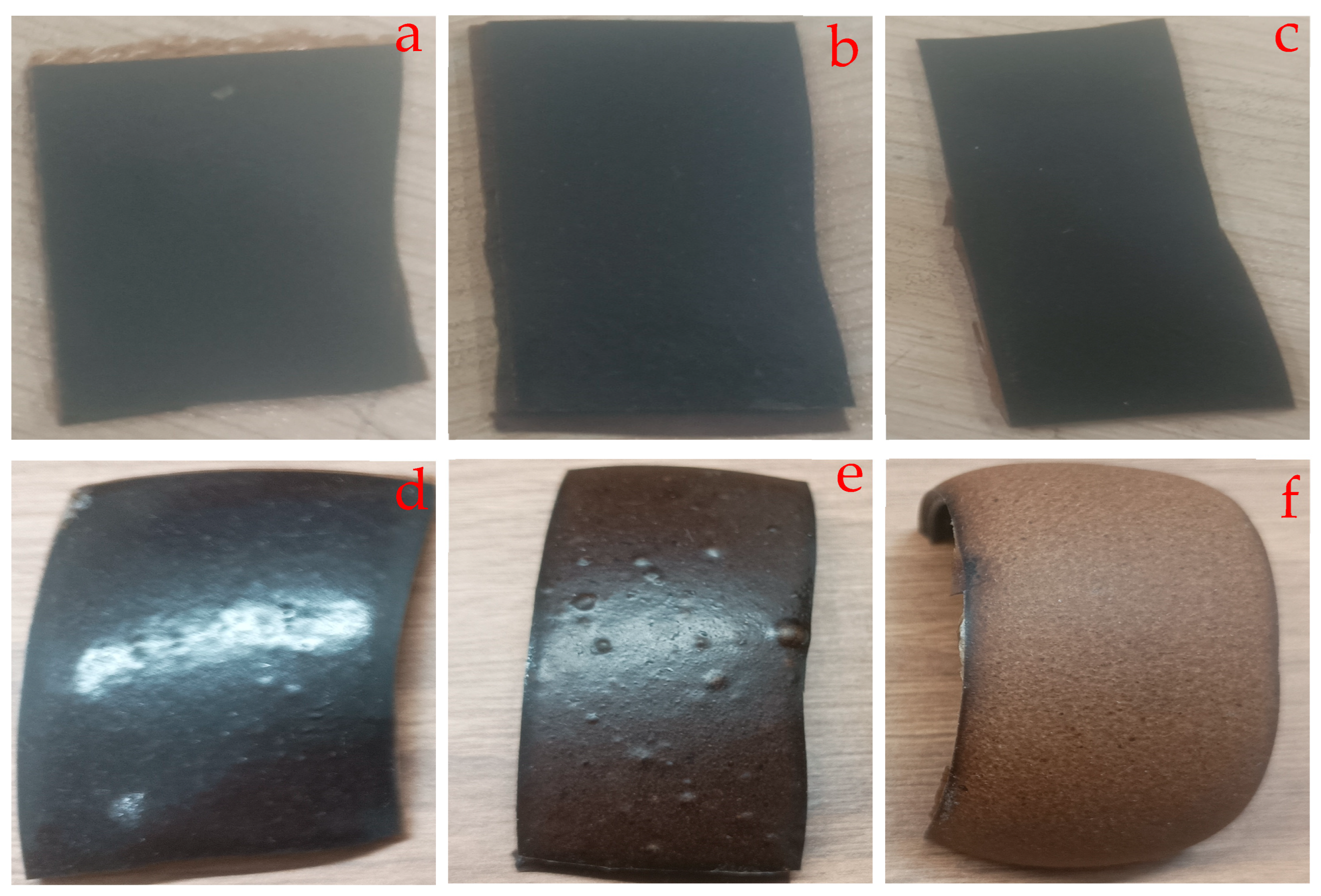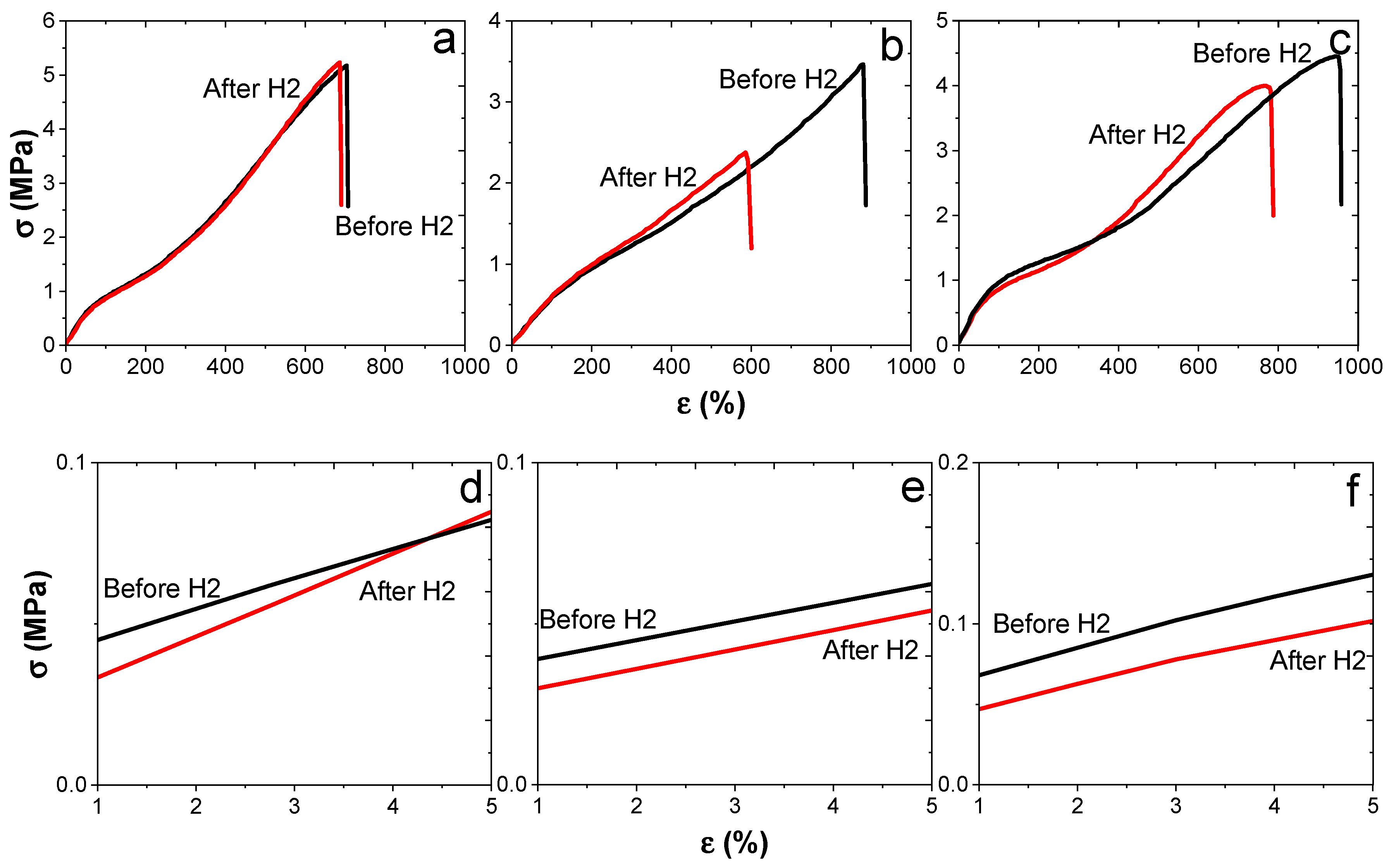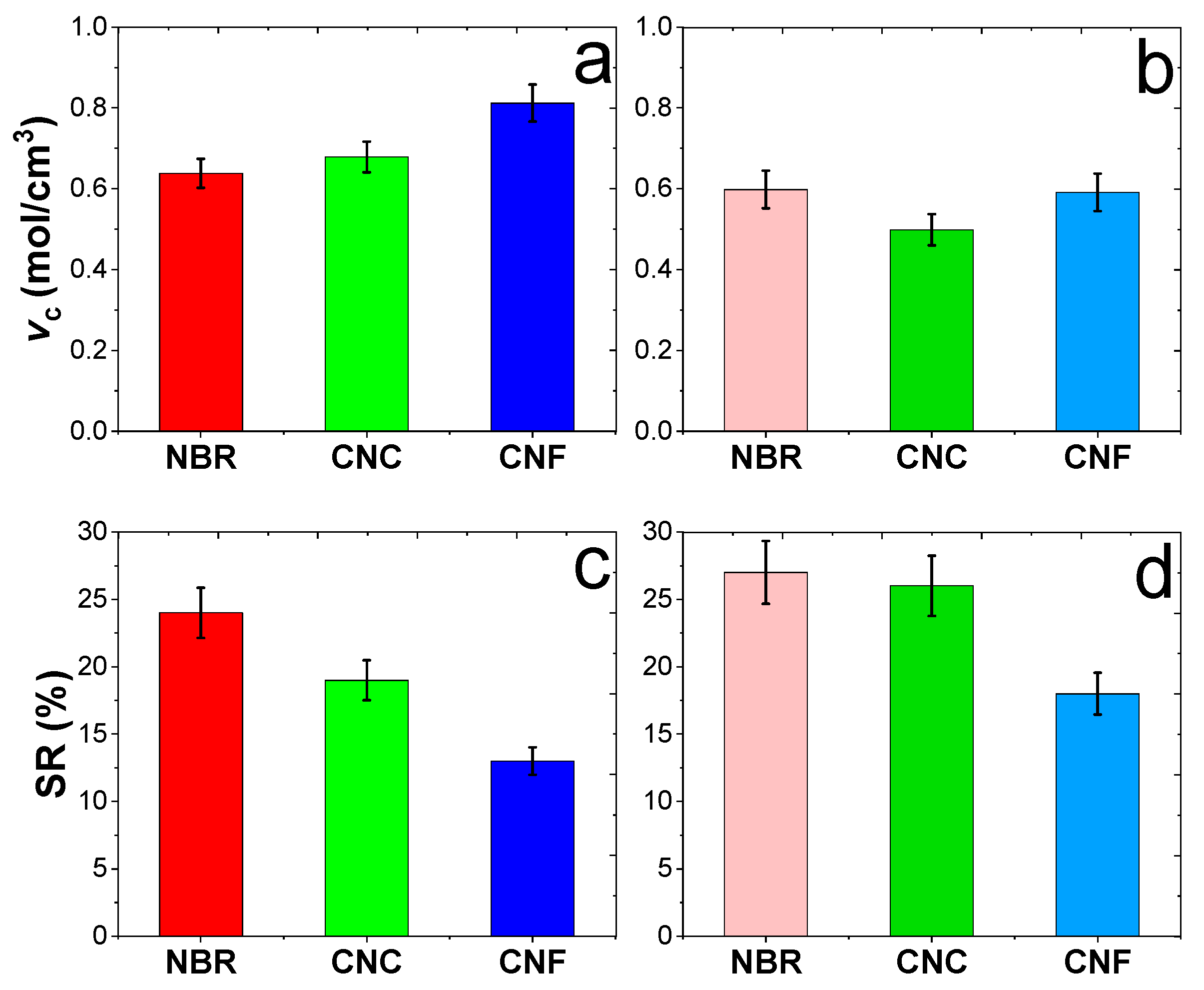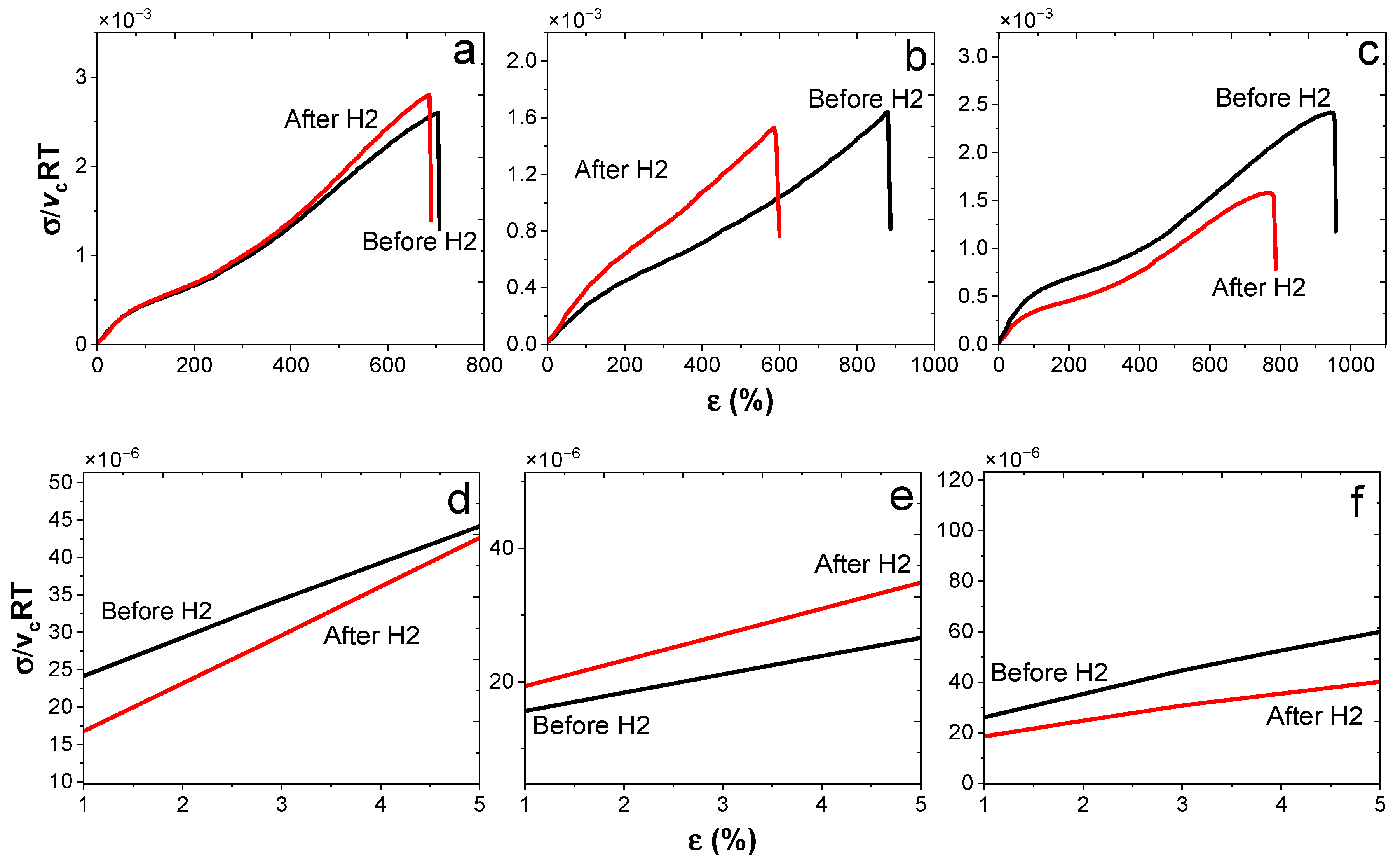1. Introduction
The hydrogen energy sector is advancing toward industrial-scale deployment; however, significant challenges remain due to hydrogen’s high volatility and low density. High-pressure hydrogen storage systems require advanced materials to ensure safety and reliability. Rubber seals, which are critical components in these systems, are particularly vulnerable to degradation under pressures up to 100 MPa [
1]. This degradation often manifests as swelling, blistering, and cracking, causing structural failure. Nitrile butadiene rubber (NBR) is commonly used in such seals due to its excellent resistance to oils, fuels, and nonpolar gasses, as well as its low gas permeability. In addition to rubber, nanofillers play a vital role in enhancing the stability and functionality of materials used in high-pressure hydrogen storage. Conventional nanofillers like carbon black (CB) and silica contribute to mechanical reinforcement but are known to absorb hydrogen, which can negatively affect material performance [
2,
3]. Furthermore, these nanofillers have significant environmental impacts, posing sustainability challenges [
4]. A promising solution lies in the use of sustainable nanofillers, such as cellulose-based nanomaterials [
5].
Cellulosic polymer nanocomposites are materials where cellulose-derived nanofillers are added into polymers to improve their thermal and mechanical properties. Due to their abundance and renewability, cellulosic nanofibrillar structures have attracted significant attention over the past two decades. Cellulose nanofillers are primarily sourced from wood, agricultural residues, and bacterial cellulose. They are notable for their biodegradability, high strength, and Young’s modulus, making them widely used in nanocomposite development. Numerous studies have focused on preparing and characterizing elastomer-based nanocomposites reinforced with nanocellulose [
6]. Various rubbers, including natural rubber (NR), epoxidized natural rubber (ENR), styrene-butadiene rubber (SBR), and butadiene rubber (BR), have been enhanced for mechanical, thermal, gas barrier, and dynamic mechanical properties [
7]. Acrylonitrile butadiene rubber (NBR) is a polar rubber known for its heat resistance, high compression set, oil resistance, and abrasion resistance. It is commonly used in products like seals, hoses, and gloves, though it is not biodegradable and lacks strain-induced crystallization [
7].
This study investigates the development of NBR latex nanocomposites incorporating cellulose nanofillers for high-pressure hydrogen sealing applications, with a focus on rubber O-rings. Cellulose nanofibers (CNFs) and cellulose nanocrystals (CNCs) are explored as sustainable alternatives to traditional nanofillers. The research uses NBR latex formulations by varying the type of cellulose nanofillers to evaluate their effects on mechanical properties, crosslink density (vc), and performance under high-pressure hydrogen exposure. Additionally, the low-carbon manufacturing potential of these nanocomposites is assessed through a life cycle assessment (LCA), demonstrating the potential of cellulose nanofillers to enhance the performance of NBR nanocomposites while reducing environmental impact, thereby enabling sustainable and low-carbon manufacturing solutions for hydrogen storage systems.
2. Materials and Methods
Nitrile butadiene rubber latex (NBR) is derived from butadiene, acrylonitrile, unsaturated carboxylic acids, and other additives through emulsion polymerization with a solid content of 43–45% and a density of 0.91 g/cm3. It was sourced from Dongguan Jiaqing Plastic Raw Materials Co., Ltd., Dongguan, China. For the reinforcing filler, CNC, with lengths from 140 to 200 nm and diameters between 5 and 20 nm, and CNF, with a 50 nm diameter and lengths up to several hundred microns, were acquired from Cellulose Lab., Canada. They were supplied in aqueous suspensions of 12.0% (CNC) and 3.0% (CNF). N-(1,3-dimethylbutyl)-N-phenyl-p-phenylenediamine (6PPD), used as antioxidant, was sourced from Anzhe Chem. Co. Ltd., Suzhou, China. The vulcanizing agents and additives, including sulfur and zinc oxide (ZnO), were attained from Zhejiang Yongjia Chem. Co. Ltd., Wenzhou, China, and Aladdin Ind. Co., Shanghai, China.
2.1. Cellulose-Filled NBR Sample Preparations
NBR nanocomposites from the latex were prepared following the formulation outlined in
Table 1, where the cellulose nanofiller suspension was mixed directly into the latex. The suspension was gradually added drop by drop into a beaker containing NBR latex, with continuous stirring for 2 h. The latex containing cellulose nanofillers was oven-dried for 12 days at 40 °C. The nanocomposites were prepared using the dried NBR latex rubber in an internal mixer (HOOK, Shanghai Kechuang Co. Ltd., Shanghai, China). Initially, antioxidant 6PPD was blended at 100 °C for 20 min at an extruder speed of 40 rpm. Afterward, sulfur and zinc oxide were introduced and mixed at 100 °C for another 10 min to complete the formulation. Sheets of vulcanized NBR for characterization were produced by compressing the compound mixture at 12 MPa using a vulcanizer (XL-25, Huzhou Xinli Rubber Machinery Co. Ltd., Huzhou, China). The sheets were compressed to a thickness of around 2.0 mm at 150 ± 5 °C for 30 min.
2.2. Hydrogen Exposure and Characterization
The prepared rubber nanocomposites were subjected to hydrogen exposure at 100 MPa for 4 h. The samples were exposed to 99.99% hydrogen in a hydraulic servo-controlled testing machine equipped with an autoclave [
1,
4]. The samples before and after hydrogen was exposed were characterized for their morphological and mechanical properties, including crosslinking density (
vc).
vc was measured according to Flory–Rehner equation
[
8,
9]. Here, V = 106.4 cm
3/mol represents the molar volume of toluene, and
χ1 is the Flory–Huggins parameter of interaction, which is taken as 0.6 for NBR. The volume fraction of the rubber,
vr, is calculated based on the following method:
. The weight fraction of nanofillers in the NBR nanocomposite is denoted as wf, and the weights of the samples in their initial (m
0), swollen (m
1), and de-swollen (m
2) states were measured. The densities of toluene (ρs = 0.887 g/mL) and NBR (ρr = 0.970 g/mL) were used for the calculations. As a mechanical characterization of all elastic properties is essential for enhancing design optimization [
10], uniaxial tensile tests were performed on NBR nanocomposites at room temperature using dog-bone-shaped specimens with dimensions of 35 mm in length, 2 mm in width, and 2 mm in thickness. The tests were conducted on an electronic universal testing machine (SANS Tech, Shenzhen, China) with a crosshead speed of 50 ± 5 mm/min, following the guidelines of ASTM D 412 standards.. Fourier-transform infrared (FTIR) spectroscopy of the NBR nanocomposites and samples exposed to hydrogen at 50 MPa was performed with a spectrometer (Nicolet iS10, Thermo Fisher Scientific Inc., Waltham, MA, USA). The scans were performed with 32 co-additions, covering a range of 4000 cm
−1 to 500 cm
−1, and a resolution of 2 cm
−1 was used.
2.3. LCA of Cellulose-Filled NBR Manufacturing
Life cycle assessment (LCA) was carried to evaluate the environmental impacts of NBR nanocomposites used for O-rings during the manufacturing phase, including raw material acquisition and processing. This study primarily focused on the manufacturing phase of rubber nanocomposites, starting from raw material acquisition to the production of the final products, using a defined functional unit (FU) of 1 kg. The goal was to measure the environmental impact of the manufacturing phase for rubber nanocomposites, specifically those made with cellulose-based NBR, aiming to highlight contributions toward low-carbon manufacturing, energy conservation and future improvements for high-performance rubber nanocomposites in high-pressure hydrogen applications. For this study, a 1 kg FU of rubber made from NBR nanocomposites including raw materials (NBR, sulfur, zinc, and cellulose acetate fibers) and energy inputs and outputs was referenced in the “gate-to-gate” LCA.
2.3.1. Lifecycle Inventory (LCI) Analysis
The LCI phase involved collecting data to track material [
11] and energy flows across the manufacturing stages of NBR nanocomposites, with compression molding and hot internal mixing to produce vulcanized rubber nanocomposites. The experimental results provided primary data, were allocated based on product mass prepared in the lab. Data on material flows (NBR, cellulose acetate fibers, sulfur, and zinc) and energy usage (electricity mix, China) were sourced using demo EIME software v6.0 [
12], supplemented with updated EN 15804+A2 and CODDE databases.
2.3.2. Lifecycle Impact Assessment (LCIA)
The LCIA phase integrated LCI data and elementary flows to evaluate environmental impacts by categorizing and characterizing the results across 17 midpoint impact categories [
4]. The impact categories that were normalized include the following: total climate change (GWP), biogenic climate change (GWPb), fossil climate change (GWPf), acidification (AP), ozone depletion (ODP), marine eutrophication (Epm), freshwater eutrophication (Epf), terrestrial eutrophication (Ept), resource use of minerals and metals (ADPe), photochemical ozone formation, human health (POCP), fossil resource use (ADPf), water use (WU), ionizing radiation for human health (IR), particulate matter (PM), human toxicity related to cancer (CTUh-c), ecotoxicity in freshwater (CTUe), and human toxicity related to non-cancer (CTUh-nc). The midpoint approach enabled comparative evaluations of production processes across all impact categories [
13], facilitating a deeper understanding of environmental trade-offs and improvement opportunities in rubber nanocomposites for O-ring manufacturing.
3. Results
Figure 1a–f illustrates the morphology of NBR nanocomposites before and after exposure to 100 MPa high-pressure hydrogen for 4 h. NBR exhibited the formation of bubbles, which increased in the CNC-filled NBR, while the CNF-filled NBR retained its microstructure under the same conditions. The bubbles are attributed to internal fractures caused by rapid decompression of high-pressure hydrogen [
2]. The CNF-filled nanocomposites showed no bubble formation but swelled to twice the size of the NBR and CNC-filled nanocomposites, suggesting enhanced hydrogen escape during decompression.
Hydrogen-induced blister fracture after hydrogen exposure is a critical failure mode for rubber O-rings in high-pressure hydrogen systems. During hydrogen exposure, hydrogen molecules dissolve into the rubber matrix and accumulate at microstructural flaws such as cavities and filler interfaces [
14,
15,
16]. When the external pressure decreases, the dissolved hydrogen becomes supersaturated, resulting in rubber swelling and the formation and growth of bubbles. These bubbles cause local stress concentration. Once the stress exceeds the cohesive strength of the rubber, microcracks initiate and propagate, forming blisters on the surface or within the material. Fillers can affect the hydrogen mechanical properties and transport properties of rubber, ultimately influencing its resistance to hydrogen-induced blister fracture. The effects of CB and silica nanofillers on the blister fracture of EPDM and NBR exposed to 10 MPa hydrogen are known to alter the blister fracture depending on the content and type of nanofiller used [
16]. In fact, fillers enhanced the tensile properties of the rubber. However, cellulose nanofillers have strong hydrophilicity, which causes them to easily agglomerate in the rubber matrix [
17]. These agglomeration sites may serve as locations for hydrogen gas accumulation, leading to hydrogen-induced blistering. This could be the reason why the blistering in CNC-filled NBR is more severe than in neat NBR.
From the images in
Figure 1, it is evident that the morphology of the NBR and the fillers in the NBR matrix are significantly influenced by hydrogen exposure. The numerous pores appeared in neat NBR, and the matrix appears relatively clean due to the lack of filler. The number of pores and bubbles in the CNC-filled NBR increases, likely due to trapped hydrogen at the interface of filler or curative agglomerates within the NBR matrix [
1,
2]. The overall sample bulging or swelling observed in CNF-filled NBR, rather than pores and bubbles, may be attributed to the higher surface area of CNF compared to CNC. This is because CNFs are more fibrous and have a larger surface area due to their longer, more flexible structure, whereas CNCs have a relatively compact and crystalline structure. The shape factor and filler volume fraction of the fillers are known to influence cavity nucleation or bubble formation in rubber materials when exposed to high gas pressure [
18,
19].
Studies have classified the interactions between nanocellulose fillers and NBR chains into two main types: (1) hydrogen bonding interactions, where the abundant OH groups on the surface of CNs allow for the attachment of NBR chains, particularly through interactions between the OH groups and the C≡N groups of the NBR; and (2) physical adsorption, which is enhanced by the nanoscale of the CNs and the similar polarity between CNs and NBR chains. This interaction reduces the mobility of the polymer chains and functions as a multifunctional cross-linker [
20,
21]. Similarly, the interactions between the nanofillers (CNC or CNF) and the rubber matrix were investigated using FTIR spectroscopy, as illustrated in
Figure 2. The FTIR spectra of neat NBR show transmission peaks at 2920–2841 cm
−1, later slightly shifted to 2922–2845 cm
−1 with the addition of nanofillers, which are attributed to asymmetric and symmetric –CH vibrations. The peak at 964 cm
−1 is associated with C-H stretching of the butadiene double bond (–CH=CH (trans)). Additional peaks at 1440 and 1098 cm
−1 are attributed to –CH
2 bending and C-O stretching vibrations, respectively. The utilization of the glycosidic rings of nanofiller chains at 1080 cm
−1 and the transition of the peak from 2232 cm
−1 to 2236 and 2238 cm
−1 indicate effective interaction between the –CN functional groups of NBR and the –OH functional groups of CNC or CNF-filled nanocomposites [
7,
22]. After hydrogen exposure at 100 MPa, the neat NBR and nanofiller-filled nanocomposites were found to be benign without any significant changes. However, slight changes in intensity and position were observed in the peaks—1098 cm
−1, 1080 cm
−1, 2002 cm
−1, 2232 cm
−1, 2236 cm
−1, and 2238 cm
−1—indicating further structural modifications after hydrogen exposure.
Figure 3 illustrates the σ-ε curves of NBR and CNC or CNF-filled nanocomposites. The addition of CNC increased the ε, while CNF synergistically increased σ and ε. The reinforcement of CNF on the reinforcement is evident, leading to an increase in tensile strength. However, after hydrogen exposure, not much change was seen in neat NBR, yielding a cumulative σ-ε curve recovery and earlier ε. The CNF-filled nanocomposites showed more recovery compared with CNC-filled NBR nanocomposites. Hydrogen acts as a reducing gas and facilitates hydrogenation reactions. Under high-pressure conditions, unexpected reactions can occur because the energy supplied by pressurization exceeds the activation energy required to transition rubber molecules into an activated state. Changes in the mechanical properties of CNC and CNF-filled NBR may suggest varied hydrogenation in the samples, as hydrogen significantly influences NBR, leading to up to 70% of NBR being converted into hydrogenated HNBR upon high-pressure hydrogen exposure [
15,
23]. Moreover, hydrogenated HNBR exhibits an ultimate strength 12 times greater than that of NBR, along with an increase in its glass transition temperature during the hydrogenation process [
24].
Nanofillers significantly influence the mechanical properties of nanocomposites; thus, the
vc and SR were evaluated both before and after exposure to high-pressure hydrogen.
Figure 4 illustrates the
vc and SR for the neat NBR and CNC or CNF-filled NBR, providing insights into the affinity of the cellulose nanofillers for the rubber chains. Strong interfacial interactions between the cellulose nanofillers and the rubber result in enhanced resistance to toluene absorption [
25,
26], increasing the
vc and lowering the SR. The notable enhancement in the
vc for NBR-CNF suggests that a higher aspect ratio filler of CNF facilitates greater
vc, resulting in a lower volumetric swelling ratio (
Figure 4c,d) for NBR-CNC. Consequently, the swelling-induced elongation of the rubber molecular chains is reduced, and the ability of the solvent to infiltrate the free volume within the rubber matrix is reduced, also reducing SR. CNFs have a higher aspect ratio than CNCs due to their long, flexible, and entangled structure, which includes both crystalline and amorphous regions. This difference makes CNFs better for reinforcement in composites, as their high aspect ratio and larger surface area improve
vc and stress transfer and mechanical properties.
The normalized σ-ε plots, which represent σ/(vcRT) versus ε, are presented in
Figure 5, where T is the absolute temperature and R is the gas constant. The dependency of neat NBR nanocomposites on
vc is visible, even after high-pressure hydrogen exposure, which is associated with the retained networks. Following the high-pressure hydrogen exposure at 100 MPa for 4 h, network defects reduce the
vc of NBR nanocomposites containing CNC or CNF. The dependency on
vc of samples prior to hydrogen exposure, which diminishes after exposure, is likely due to a reduction in crosslinked networks.
The environmental impacts associated with the manufacturing phase of NBR-based nanocomposites filled with cellulose fibers are evaluated across 17 midpoint categories, as shown in
Figure 6. The comparatively low toxicological profile of CNC and CNF relative to carbon black or silica suggests a reduced potential for environmental and health hazards. The electricity consumption for manufacturing one kilogram of NBR product (gloves) can reach up to ~10 MJ [
27]. Moreover, the energy-intensive processes required for the production of cellulose fibers (micro- and nano-scale) substantially contribute to the overall environmental impact, highlighting the significant energy demand associated with their synthesis and processing [
28,
29]. Consequently, for the production of 1 kg of CO
2-based rubber, emissions range from 4.57 kg CO
2 eq, in the best-case allocation scenario, and 4.83 kg CO
2 eq in the worst-case allocation scenario [
30]. The earlier LCA studies on CNF focused on a cradle-to-gate assessment for producing one ton of CNF, utilizing sulfite pulp as the raw material and comparing various distinct processing routes. These studies highlight significant differences in wastewater production across the different processing routes for the production of CNF. The enzymatic pre-treatment process produced higher yields but required more energy compared to other chemical pre-treatment methods [
31]. Addition of cellulose fibers to the NBR nanocomposites, increases Global Warming Potential (GWP) from 2.3 to 2.5 kg CO
2 eq., primarily due to increased reliance on resources during processing. Adding bio-based cellulose nanofillers in NBR nanocomposite manufacturing increases several environmental impacts, notably in Ept (eutrophication of freshwater, marine, and terrestrial environments.













